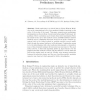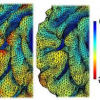157
click to vote
Publication
The space-time geometric structure of Maxwell’s equations is examined and a subset of them is found to define a pair of exact discrete time-stepping relations. The desirability ...
165
click to vote
Publication
I. Introduction
II. Foundations
A. The Mathematical Structure of Physical Field Theories
B. Geometric Objects and Orientation
1. Space-Time Object...
116
click to vote
SIAMNUM
2010
14 years 8 months ago
2010
A number of works concerning rigorous convergence theory for adaptive finite element methods (AFEM) for controlling global energy errors have appeared in recent years. However, man...
114
click to vote
PROCEDIA
2010
14 years 8 months ago
2010
We argue that producing maintainable high-performance implementations of finite element methods for multiple targets requires that they are written using a high-level domain-speci...
101
click to vote
MOC
2010
14 years 8 months ago
2010
We derive in this paper a unified framework for a priori and a posteriori error analysis of mixed finite element discretizations of second-order elliptic problems. It is based on ...
118
click to vote
MOC
2002
15 years 25 days ago
2002
We consider a family of tensor product finite element methods for hyperbolic equations in RN , N 2, which are explicit and generate a continuous approximate solution. The base cas...
113
click to vote
JSCIC
2008
15 years 1 months ago
2008
In this paper we shall discuss the numerical simulation of higher order geometric flows by level set methods. Main examples under considerations are surface diffusion and the Will...
137
click to vote
CORR
2007
Springer
15 years 1 months ago
2007
Springer
Abstract. Mesh numbering is a critical issue in Finite Element Methods, as the computational cost of one analysis is highly dependent on the order of the nodes of the mesh. This pa...
115
click to vote
SMA
2010
ACM
15 years 1 months ago
2010
ACM
Whereas traditional finite element methods use meshes to define domain geometry, weighted extended B-spline finite element methods rely on a weight function. A weight function is ...
101
click to vote
ISBI
2004
IEEE
16 years 1 months ago
2004
IEEE
Surface data such as the segmented cortical surface of the human brain plays an important role in medical imaging. To increase the signal-to-noise ratio for data residing on the b...



